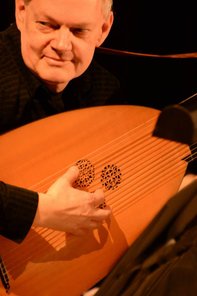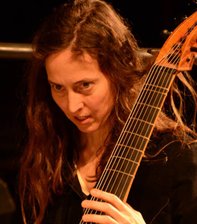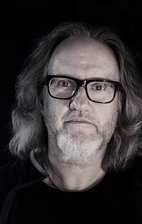Kent Olofsson - Composer
Lipparella
Champs d'étoiles
Suite for countertenor, recorder, baroque violin, theorbo, viola da gamba and electroacoustic music (2008-16)
Champs d'étoiles is a musical suite that builds on texts and thoughts on the pilgrimage as a quest for deeper insights into the timeless mystery of being human. The work is also about musical timelessness. I have always been deeply fascinated by the music and instruments from the Renaissance and Baroque eras and this work is about new music for period instruments. The close collaboration with the musicians of Lipparella, experts on both early and new music, has been the cornerstone of the work. Compositionally I have interweaved styles and techniques from contemporary music as well as from older music. I have aimed for a music with a distinctive, peculiar tone that is both harsh and beautiful at the same time.
The composition of Champs d'étoiles became a long journey. The first parts were composed in 2008, and the last in 2016. In the process I gradually understood that the texts, stories and ideas about the pilgrimage I had taken as a starting points, were in fact foremost about myself, my own quest and the joint journey with the musicians. A journey that still continues. The completion of the music on this CD was prompted by the realisation of a theatrical performance called I skuggorna (In the shadows), where the music of Champs d’étoiles was the central element.
Champs d'étoiles was awarded the Järnåker scholarship in 2016, one of the larger grants for composers in Sweden.
Kent Olofsson
*
Des Sommers Wochen standen still - Rilke Trio I
(Countertenor, bass recorder, theorbo)
Des Sommers Wochen standen still,
es stieg der Bäume Blut;
jetzt fühlst du, daß es fallen will
in den, der alles tut.
Du glaubtest schon erkannt die Kraft,
als du die Frucht erfaßt,
jetzt wird sie wieder rätselhaft,
und du bist wieder Gast.
Der Sommer war so wie dein Haus,
drin weißt du alles stehn –
jetzt mußt du in dein Herz hinaus
wie in die Ebene gehn.
Die große Einsamkeit beginnt,
die Tage werden taub,
aus deinen Sinnen nimmt der Wind
die Welt wie welkes Laub.
(Rainer Maria Rilke, from Das Stunden-Buch: Das Buch von der Pilgerschaft)
Translation
The summer’s weeks halt and no longer
drive the trees’ blood
but seem to let it fall at last
to the Cause of all.
Midsummer force was tangible
as fruit in your grasp,
but now reclaims the ineffable
and you – are again the guest.
The summer has been your own house
and your life’s drift stayed;
now you must travel out to your heart
as across the plains.
The enormous solitude begins;
the days grow deaf;
your senses lose their world to the wind:
dried leaves reft.
(Translation Susan Ranson)
*
Single Form
(Countertenor, viola da gamba, theorbo)
Dyningen som faller,
muskeln när den spännes
lyder samma lag.
Linjens lätta böjning
samlar kroppens kraftspel
i en djärv balans.
Skall mitt sinne finna
denna stränga kurva
på sin väg till form?
(Dag Hammarskjöld, from Vägmärken (Waymarks))
*
Interlude I: Pulsar steps
(Electroacoustic music)
Fifty years ago a young astronomer detected a radio signal from space. It caused a sensation. The signal was so regular that it was taken to be message from other civilisations. It turned out that the signal came from a pulsar that was created by the explosion of a supernova.
When I was a child I often went out at night to look at the stars in the sky. The name of the constellations of stars gave me associations. I dreamt about places far away. Other places. Other times. This place and this time. Here and now. *
*
Und höher, die Sterne - Rilke Trio II
(Countertenor, violin, viola da gamba)
Und höher, die Sterne. Neue. Die Sterne des Leidlands.
Langsam nennt sie die Klage; – Hier,
siehe: den Reiter, den Stab, und das vollere Sternbild
nennen sie: Fruchtkranz. Dann, weiter, dem Pol zu:
Wiege; Weg; Das Brennende Buch; Puppe; Fenster.
Aber im südlichen Himmel, rein wie im Innern
einer gesegneten Hand, das klar erglänzende M,
das die Mütter bedeutet ...... –
*
Making music is to travel. I like that feeling. The feeling of being in motion. It comforts me. I navigate through my dreams.
The stars reaches out to us. We can measure the faint light in the moment of them dying before they become ghosts. We can measure the signals from a collapsed supernova. But how can we measure the weight of a parent that dies, or the lightness when we have a child?
I hold on firmly close to the ground. Hard. I try not to fall. I hope the thin membrane of rain and oxygen and clouds prevents me from falling.
We don’t fall. We are still down here. Our boots stuck in the mud. Our hands dirty of soil.
Here is hope. In this moment. In music. In the heart where we save the memories of those we love.
We do not fall. *
(* Texts by Jörgen Dahlqvist and Kent Olofsson for the performance I skuggorna.)
The world unfolds in front of me. A landscape. Touches and nervous laughter. Friendly and unfriendly faces. Fragile hearts. Memories. Rainy mornings. Cold autumns. Hands that have become dirty of soil. Boots that are stuck in the mud. I hold on firmly close to the ground. Hard. I try not to fall. I hope the thin membrane of rain and oxygen and clouds prevents me from falling. I hope I can hold on to the earth. *
The word pilgrim means stranger. Someone that comes from afar. One of the most important pilgrimage routes in Christianity is the one that leads to Santiago de Compostela where the apostle Jacob is said to be buried. The pilgrims of the Middle Ages navigated through the stars and it is said that the name Compostela originates from that.
The way of the stars. Or the starlit way. *
Interlude II: Pulsar Dance
(Electroacoustic music)
Stars die at different ages. And we see the light many millions years after they have died. The dead stars become supernovas. Nebulae. Black holes. The starry sky is made up of millions of living and dead stars.
The image of a ghost. *
Okända rum - Reaktorhallen 2014
Chemin de silence I-III (2010)
for theorbo
Written for Peter Söderberg
Recorded by Peter Söderberg on the CD "Liuto con forza (Phono Suecis), recorded by Torbjörn Samuelsson. Track 11-13 in the playlist.
Vocations - for viola da gamba (2014-15)
Written for Louise Agnani
Text from the thesis Composing the Performance.
Moving my compositional practice into the field of contemporary theatre has transformed and expanded my artistic practice. However, this has not meant that I have stopped composing concert music. Most of the pieces of concert music I have composed over the years of the doctoral studies have been highly influenced by the experiences from the theatre work, or have been composed both as staged performances and as stand-alone concert pieces. The works I like to highlight here, that I myself find particularly interesting and successful as musical compositions are Intérieur/Extérieur for Paetzold contrabass recorder, contrabass flute and electronics, Man’s Desire to be God, an art rock project, Champs d’étoiles, a suite for counter tenor and period instruments and Arrival Cities: Hanoi, composed for a trio of Vietnamese instruments, chamber ensemble, and electronics. What unite these very different pieces is that the music in each case was created within its own ‘conceptual universe’: a specific weave of musical material and traditions, theatre methods, narratives, texts and relation to performance situation have shaped the context and conditions for the composition. In fact, for most of these works it is perhaps not correct to talk about pieces but rather suites, longer works that consist of many musical pieces in themselves.
As the very final part of my thesis, as an epilogue, I will briefly discuss the creative process of Champs d’étoiles and how the experiences from my work in theatre influenced the completion of the work. The creation period for this large-scale suite was very long. It begun one year before I started this doctoral studies and it went on a very extensive time, for over eight years. It is thus a work that has accompanied me in my studies over the years. The final work and its completion were highly influenced by my work with the theatre; the result would have been rather different without these experiences. The work was composed especially for the musicians in the ensemble Lipparella. Writing for the highly specialized musicians, their skills and personalities and the special dynamic of the ensemble was influential and most decisive for the composition. Although the creative process was characterized by a traditional way of writing and performing chamber music, there was also a strong collaborative aspect. The work would have been very different without our close connection and most likely, the work would not have been composed at all.
While the first separate movements I composed with text by Rainer Maria Rilke and others worked out really well, I could not find how to shape an overall form for the longer suite I intended to create. The process to complete the suite went through two staged versions, Okända rum (Unknown Spaces) and I skuggorna (In the Shadows). For each of these I composed further new movements. In the early stage of composing the work I tried to construct an overarching form through mathematical, geometrical and literary ideas. They did not work however, as I felt they had not any real concept or direction for the piece, the logic the ideas provided was only paper constructions. As stated, the first movements I composed worked out really well; they had their own meanings and directions through the connection and relation to the poems. It was the overarching form that was the problem.
When we created the first staged version, Okända rum, I used the music I had already composed as well as composing new parts. Together with the ensemble, Jörgen Dahlqvist and video artist Maria Norrman we created a performance with music performance, lights and video projections that consisted of both filmed material and projected poems. The performance was created especially for the old reactor hall in Stockholm, R1, a gigantic hall 25 meters below ground that was the first nuclear reactor in Sweden. The ideas for the performance evolved out from the themes and poems I had started out from in the first parts: the pilgrimage and texts by Rilke and Rimbaud.
The old tales of the pilgrims navigating their journeys with the help of the stars became a central idea and the hall was filled with small lights, a field of stars, Champs d’étoiles. The new parts I composed were not only composed in relation to the overall dramaturgical ideas we had but also in the relation to the special space. Most of the new compositions were composed with special placement of the musicians in the hall. In one part the five musicians were placed far apart, creating a spatialized music that travelled in the huge space. Two years later we did the other staged version,I skuggorna. For this I composed the last parts of the suite. In this performance I was actually myself on stage as a narrator performing a text written by Dahlqvist and me. This was partly autobiographical, partly from the poems used for the music and other sources, interconnected through the central concept of the suite: the pilgrimage. Again the idea with the stars as navigation light was present. A new idea was to use the sound of pulsating stars, recorded by an astronomer. In this performance I also used pre-recorded material: the sounds of the stars were transformed to the sound of someone walking, connecting the immense lifetime of the stars with our human lives. In the very last part I combined the ensemble with the stars and the steps, they came together in a walking, in a heavy relentless pulse. Here everything was united and connected, the pilgrimage, the wandering, the ensemble, the music and my own search. Here was the core of the work. And from here new journeys and new explorations begin.






